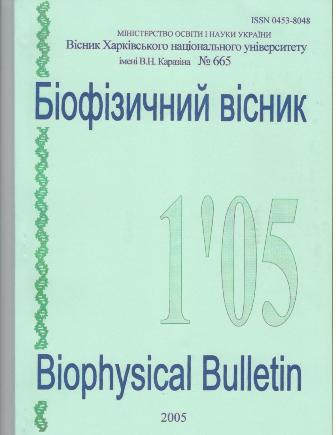Biophysical mechanisms of long-distance transport of liquids and signaling in high plants
Abstract
Wave phenomena have been observed in numerous experiments with whole plants. One of the possible mechanisms of long-distance high-speed signaling in high plants is connected with concentration waves that can propagate through the conducting systems of plants. The one-dimensional axisymmetrical stationary flow of a viscous liquid with an osmotically active dissolved component through a long thin rigid cylindrical tube is considered as a model of the conducting vessel of the plant. Constant concentrations of the component at the inlet and outlet of the vessel are maintained by the live cells of the vegetative organs of the plant. Nonlinear concentration distribution along the tube and the parabolic velocity profiles are obtained. Propagation of small excitations of concentrations and velocities along the tube is considered. Expression for the wave velocity U is presented. The range U=20-60 m/s is obtained by numerical estimations at wide variations of the parameters within the physiological limits. The time delay in signal transmission in the system root-leaves corresponds to the experimental data. In that way, the concentration waves can mediate the high-speed transferring of information between the organs of plants.
Downloads
References
Nardini A., Tyree M.T., Salleo S. Xylem cavitation in the leaf of prunus laurocerasus and its impact on leaf hydraulics//Plant Physiol. 2001. v.125. P.1700-1709.
Lazareva N.P., Borisova T.A., Zolkevitch V.N. On the auto-osciliating character of pumping action of Zea Mays I., root system //Dokl. Akad. Nauk SSSR. 1986. P.761-764.
Karmanov V.G., Lialin O.O., Mamulashvili G.G., etc. Water exchange dynamics of high plants and its informational role//Physiol. Biochim. High Plants. 1974. v.6. P.69-75.
Karmanov V.G., Meleshchenko S.N. Mechanism of auto-oscillations of water metabolism in plants. //Biofizika. 1982. v.27. P.144-149.
Wagner O.E. Anisotropy of wave velocities in plants: gravitropism //Physiol. Chem. Phys. Med. NMR. 1996. V.28. P. 173-186.
Wagner O.E. A plant's response to gravity as a wave phenomenon//J. Gravit. Physiol. 1999. v.6. P.17-18.
Zolkevitch V.N., Gusev N.A., Kaplia A.V., etc Water exchange in plants. Moscow: Nauka. 1989. 256 p.
Henton S.M., Greaves A.J., Piller G.J., Minchin P.E. Revisiting the Munch pressure-flow hypothesis for long¬-distance transport of carbohydrates: modeling the dynamics of solute transport inside a semipermeable tube //J. Exp. Bot. 2002. v.53. C.1411-1419.
Kizilova N.N., Pozdniak L.O. Mechanisms of long-distance liquid transport and signaling in plants. // I Ukrainian conf. “Problems of biological and medical physics”. Kharkov. 2004. P. 180.
Thornley J.H., Johnson I. R. Plant and crop modeling: A mathematical approach to plant and crop physiology. Oxford Univ. Press. 1990. 298 p.
Wei C., Tyree M.T., Bennink J.P. The transmission of gas pressure to xylem fluid pressure when plants are inside a pressure bomb//J.Exp.Botany. 2000. v.51. P.309-316
Kizilova N.N. Transport of fluids in plant leaves: movement through the porous media with distributed sources //International conference "Physics of the liquid matter: modern problems". Kyiv. 2001. P. 182.
Kizilova N.N. A computational approach to optimal transport network construction in biomechanics //Lecture Notes in Computer Science. 2004. v 3044. P.476-485.
Authors who publish with this journal agree to the following terms:
- Authors retain copyright and grant the journal right of first publication with the work simultaneously licensed under a Creative Commons Attribution License that allows others to share the work with an acknowledgement of the work's authorship and initial publication in this journal.
- Authors are able to enter into separate, additional contractual arrangements for the non-exclusive distribution of the journal's published version of the work (e.g., post it to an institutional repository or publish it in a book), with an acknowledgement of its initial publication in this journal.
- Authors are permitted and encouraged to post their work online (e.g., in institutional repositories or on their website) prior to and during the submission process, as it can lead to productive exchanges, as well as earlier and greater citation of published work (See The Effect of Open Access).





